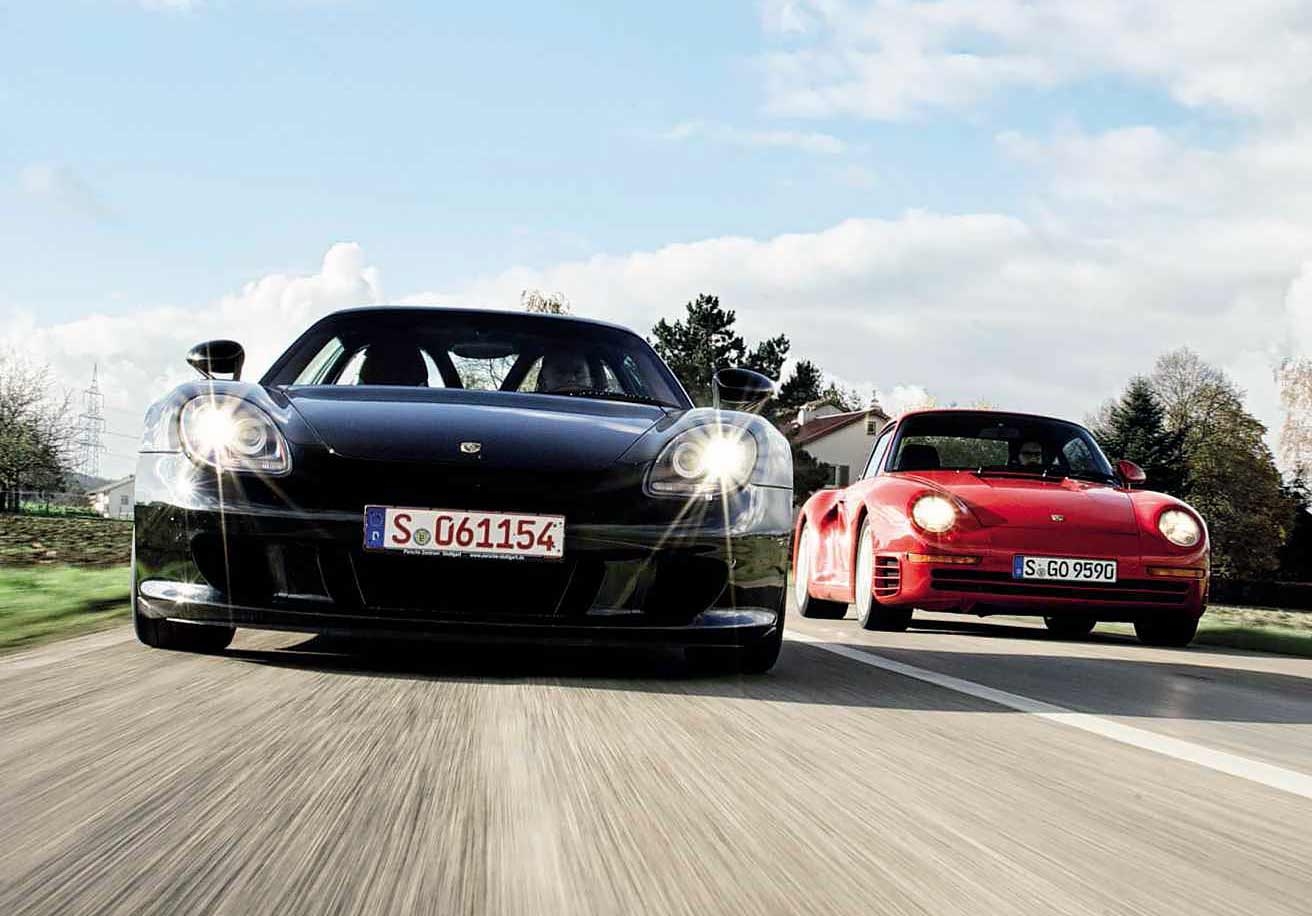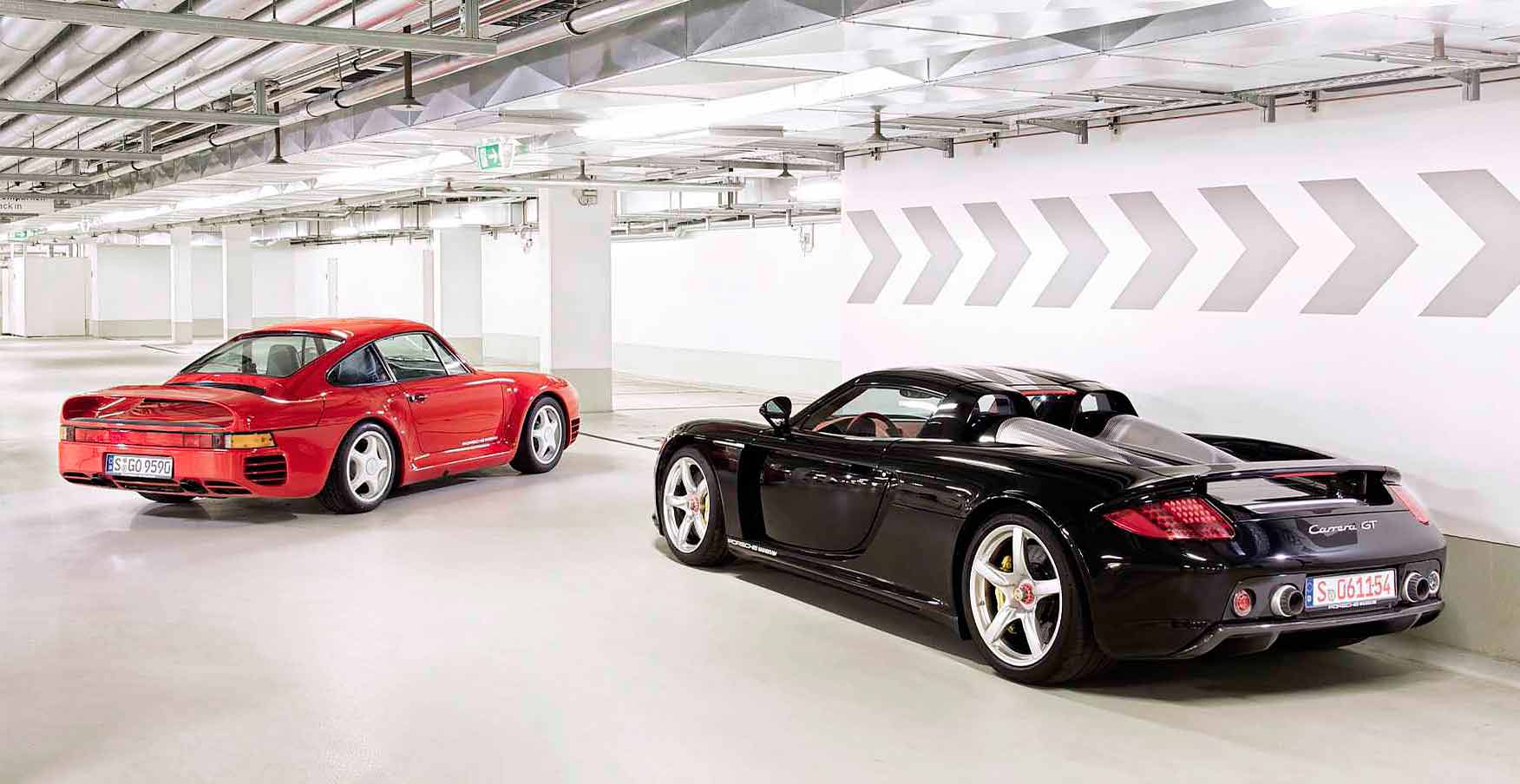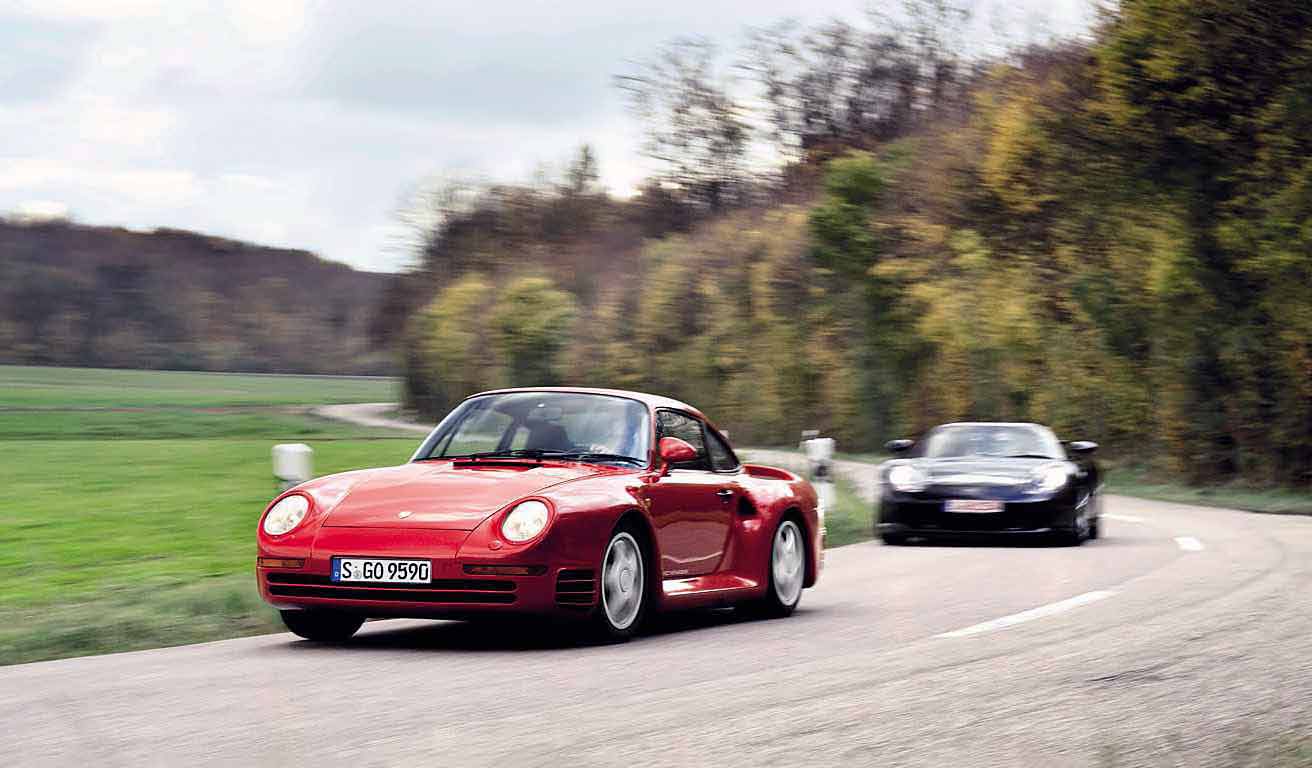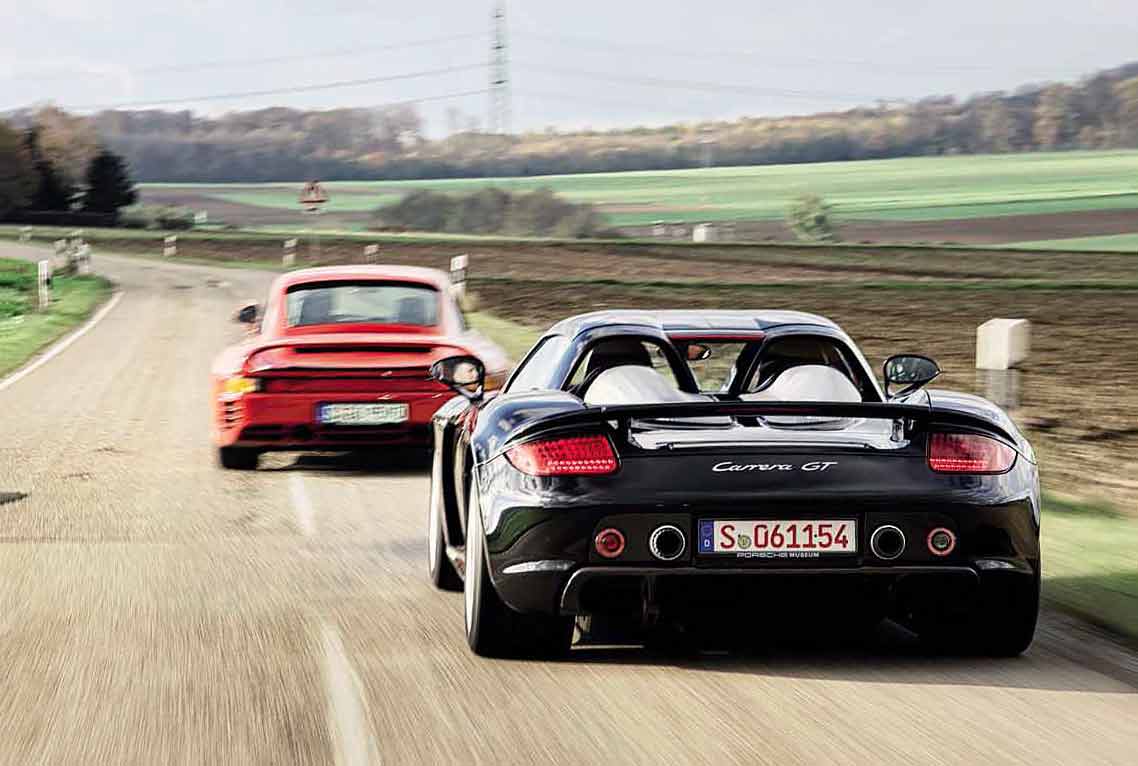
Porsche 959 Sport & Carrera GT Henry Catchpole ponders what connects these two iconic Porsche supercars (the answer’s just below, as it happens…) The forthcoming 918 Spyder is Porsche’s fourth high-end supercar. We revisit its ancestors, starting with the stars of the 1980s and 2000s: the 959 and the Carrera GT. Text by Henry Catchpole. Photography By Tom Salt.
Time Warp Speed
What does ‘G’ stand for? ‘R’ is familiar, and the numbers one to five ring a bell, but ‘G’? That’s a novel addition. It’ s sitting proudly where the ‘1’ would usually be, or in other words, just where I was about to instinctively slot the lever. I only looked down because this is the first time I’ve driven a 959 and you never know when a dogleg might be in the offing. Lucky I did, or who knows what might have happened? Time portal? Vertical take-off? It’s exciting, though, and exactly the sort of surprise I would have hoped for from the famously tech-laden Teuton. Some 30 years after the first 959 concept was shown, we now have more switchable parameters on most cars (including the new 918) than you can shake an iStick at, yet the 959 has got me stumped inside ten seconds. Excellent.
[trailer_box style=”7″ image=”images/2018-USA/2004-2.jpg” title=”1987 Porsche 959 Sport vs. 2004 Porsche Carrera GT” url=”https://drive-my.com/en/test-drive/item/2821-1987-porsche-959-sport-vs-2004-porsche-carrera-gt.html”][counter count_end=”1012″ prefix=”Power ” suffix=” bhp” count_color=”#ffffff” text_color=”#ffffff”]Total power[/counter][/trailer_box]
I’m only driving round the corner to meet the Carrera GT, so as soon as I stop, I fire up some data roaming to discover that G is for ‘Gelände’, which essentially means off-road. So it’s a creeper gear, shorter than first. I wonder how many owners have used it in earnest? I imagine this car is more likely than most to have had it tested as it’s a pre-production example that now resides in the Porsche Museum in Stuttgart, which is where we are today. The Basalt Black Carrera GT that joins it is also from the museum and also a pre-prodcar. Together, they represent half of Porsche’s eclectic supercar dynasty.

In some ways they make a very odd pairing to compare, but if you look at the full quartet – 959, GT1, Carrera GT and 918 – it’s a slightly odd family as a whole, with no terribly obvious thread of inspiration connecting them all.
The 959, for example, was initially inspired by Group B regulations before becoming an exercise in demonstrating Porsche’s tech knowhow.
The CGT, on the other hand, was born out Of customer demand. The concept shown at the Paris motor show in 2000was only designed to attract attention, but such was the reaction that the board decided it must be built.
You could argue that there is a motorsport link to both the cars here, particularly in their engines: the 959’s 2849cc flat-six with its water-cooled heads (but air-cooled block) is obviously the kin of the 961’s motor, which in turn traces its roots throughthe956/962back to Moby Dick and the other 935-type cars. The CGT’s 5.7-litre V10 stems from an F1 engine that morphed into an LMP1 engine (via Indy Car) before being plonked into the Carrera GT concept, originally as a 5.5-litre unit. But even this link between the two cars feels distinctly tenuous, because the Carrera’s engine choice seems fortuitous whereas the 959’s was intentionally reasoned through homologation.

As both cars sit quietly in the immaculate underground lair beneath the museum, they look like they could be part of an installation in an art gallery. Again, though, just by looking at their shapes you would only ever put them as very distant cousins. The Carrera GT is very high-waisted and all hunched up, while the bodywork surrounding the 959’s delicate glasshouse looks low by comparison, and that amazing, wide rear deck looks incredible.
There’s obviously a lot of 911 in the 959, although the appearance is a little like those disturbing Photoshop pictures where a skinny person’s head has been put onto a Schwarzenegger body. The colour scheme of this car, with its white centre-locking hollow-spoked magnesium alloy wheels and Guards Red paint, means it also looks like an excellent substitute for some reindeer and a sleigh.
Eventually the static photos are done and we can head outside onto the road. So I swing the aluminium door open and get back into the 959, where the interior initially feels slightly disappointingly like a standard 911’s. As the gearknob has already alluded, however, the devil’s in the 959’s details.
An extra stalk sprouts from the right-hand side oft he steering column. Nudge it up or down and you change which one of the four lights in the small dial directly above is illuminated, indicating which mode you have selected for the Porsche-Steuer-Kupplung (PSK) four-wheel-drive system. Your options are Sunshine, Rain, Ice and fully locked, and there are small needles showing the torque distributed to the front and rear diffs. There is no centre diff as such: the torque split is instead managed by a multiplate clutch (PSK literally translates as Porsche control clutch), it self controlled by computer.
Down on the transmission tunnel just ahead oft he gearlever is a single switch that controls the adjustable damping. If you know your 959s then this will make your ears prick up because most 959s would have two switches here, the other one controlling the adjustable ride height.
However, this is a rare 959 S, the S standing f or Sport. Just 37 were produced (or maybe 29, or possibly only six – the numbers are sketchy…), with manual window winders, no air con, just one door mirror, manually adjusted cloth seats and no rear seats. The S is claimed to weigh some 100kg less than the standard Comfort car and has 64bhp more – 508bhp, up from 444. It is undoubtedly the version we would have been clamouring to try had evo existed in 1987.

Twist the key and the engine starts slightly lazily, almost reluctantly. Towards you and back for first gear, then a healthy number of revs as you bring the clutch up through its relatively high biting point… and we’re off. The stop-start traffic outside the museum on this cold but dry November day reveals that the 959 is really no more difficult to drive than a normal 911 of similar vintage. You’ve got the same airy feeling in the cabin, with great visibility all round, and despite the greater breadth of the Kevlar bodywork, it feels positively small amongst modern traffic.
Initially it doesn’t really feel any more potent than a normal 911, either. I ’m following the Carrera GT and as I don’t know where I’m going, keeping up is imperative, but below 3000rpm the 959 doesn’t exactly feel imbued with oomph. Things sound better as you go through 3000rpm, the engine suddenly taking on a more recognisable flat-six timbre, but the pace still isn’t particularly brisk. The gaps in the traffic are fleeting during the first few crowded miles but the high tailpipes of the CGT leap forward at every opportunity. Meanwhile, even holding on to second gear in the 959, there doesn’t feel like there’s ever enough room to do more than tickle the underbelly of its performance.
Thankfully, we soon turn off the trunk road and the traffic melts away. In front, the black rear end of the CGT squirms a fraction and then yowls off, its rear tyres whipping up a fine plume of dust from the rural road surface. This looks better: second gear, revs building smoothly through the note change at 3000rpm, then continuing until about 4500rpm, where there’s a slight hesitation. It’s like a mapping glitch as the car pauses just momentarily, its progress stalled for a fraction of a second as though it’s stumbled. Then everything changes. The noise switches completely to something much louder, deeper and all-consuming, the roar filling the cabin and resonating in your head. It’s physical even before you consider the acceleration…

If you don’t immediately lift off the throttle in sheer bewilderment and you’re above 4500rpm then you’re launched down the road at a mind-boggling rate. I don’t say that lightly either, given that I’ve spent the rest of the week back in the UK being battered by the performance of the latest 911 Turbo. I’d heard that the 959 was meant to deliver its power progressively thanks to its sequential turbocharging, but the kick at 4500rpm is anything but seamless. (If you’re wondering how the sequential turbocharging works, it means that initially only the smaller KKK turbo kicks in – while the flow of exhaust gases is too feeble to run two turbos – bypassing the larger KKK until 4200rpm.)
Snatch the gearlever straight back into third and the 959 continues charging like the Light Brigade until the first corners appear and there’s a need to lean into the relatively reassuring brake pedal. The steering is slightly uncommunicative around the straight-ahead and you don’t get the lovely talkative sensations you feel in the best Porsche helms, but as soon as you turn into the corner and load up the surprisingly soft suspension, you get more feedback. This may be the lighter variant of the 959, but it still feels like quite a weighty car that needs a bi t of effort from your arms to get it turned in. But fundamentally, there’s a huge amount of grip available and after a while you find yourself slinging it at corners and getting on the power much earlier than you’d ever dare to in a 911 from the same period.
As confidence increases, so you can feel the nose pushing a fraction if you’re aggressive on the way into a turn, but it’s a surprise just how fast you’re going when this starts to happen. A little lift will tuck the front-wheels back on line, or if you’ve got more room then you can simply open the steering a bit and keep feeding the power on until it drives the rear round more. In tighter corners you can more easily sense that there’s still a 911-type balance underneath the 959’s grip and there’s quite a bit of roll to work with too. Following the Carrera GT through a tightish left-hander, it certainly looks like I’ve got much more time and room for adjustment than the hyper-alert V10.
Although the chassis’ grip and sway are interesting, it’s undoubtedly the 959’s monster power delivery that makes the biggest impression. You’re always looking for a stretch of road that’s open enough to stir that number two turbo, because once the second snail’s lit and chuffing there’s the slightly uncomfortable feeling of everything running away from you, like you’ve just snagged a passing Eurostar and are now trying to hang on and steer it down a small road. Admittedly, thanks mostly to the 959’s traction, there’s not the feeling of loopy lightweight craziness you get when an F40’s engine comes on boost and tries to kill you, but the 959 Sport’s roaring 508bhp feels like it’s almost unstoppable and too much for it to cope with as the rear squats, the nose rises and the A-pillars start to look very spindly indeed…
Reach for the handle hidden in the side of the car and unlatch the Carrera GT’s door, but before you get in, have a look for the secret cubbyhole. It’s at the top of the doo r o n the end and you access it by a panel that you press so that it springs o pen. I like details like that. The thinly padded carbon bucket seat feels raw and hard after the relative comfort of the 959’s chairs. Twist the key in the dash all the way round to the right and, just for a moment, the engine sounds like it’s got a at battery, doing one lazy turn-over before it wakes up.
A defining feature of the CGT is its ceramic clutch. The diminutive diameter of it allowed the engine to be mounted much lower, but by reputation you’d wonder if this was worth it as there are numerous stories of them lasting a pathetic number of miles and being incredibly tricky to use. The key to both these issues is to not use the throttle when you’re pulling away.
Don’t even touch it. Even on a hill start, just when you’re sure that the revs are fading and the V10’s about to fall abruptly and embarrassingly silent, don’t touch the throttle. It feels very odd and still takes a sensitive and steady left foot to get it creeping off the line smoothly, but if you trust the clever anti-stall technology then it works a treat and doesn’t wear the clutch out.
Once you’re up and running you can use the three pedals just as you would normally, but you’ll probably use them more than you would normally simply because changing gear is such a joy. The high-set gearlever with its polished birch wood cap can be flashed through the six-speed ’box with incredible speed and you only need to move your wrist to ick it around the gate. It’s almost as though the lever isn’t connected to anything, so free is the action. Of course that would be no use were it not matched by the response from the engine, but the V10 shows its original F1 roots by revving with the non-existent inertia of a little two-stroke.
It’s not just the physical act of pressing pedals and moving your hand, it’s the spine-tingling shriek you orchestrate on blipped downshifts that really keeps you swapping cogs as often as possible. The yeeoww emitted with every flare of revs is one of the best, most evocative things I’ve ever experienced in a car, or anywhere else.
Amazingly, these two cars are roughly similar in weight (1350kg for the 959 Sport, 1380kg for the CGT), but the Carrera feels by far the lighter. The engine, gearshift and sparse interior are part of this but there are other things, too. The steering, for example, has less resistance to inputs than that of any 911 I’ve experienced, yet it possesses the same clarity, precision and feedback as the best I’ve felt. The chassis adds to the impression of lit he minimalism too, because every lateral twitch is communicated instantly to the seat of your pants, so the whole car feels sensationally alert from the moment you begin changing direction. There’s a real edge too, the car reacting like it has an Elise chassis that has tensed its muscles to bursting point.
Ever since trying a CGT with modern Michelin Pilot Super Sports, we’d recommend them wholeheartedly. The newer rubber’s greater adhesion just seems to better match the abilities of the carbon chassis, making it easier to lean on the sidewalls, work the car through corners and use the 604bhp with far greater freedom. The naturally aspirated engine’s delivery is obviously the polar opposite of the 959’s, with a linear pull all the way through its rev range. And much as that makes it easier to work with – and more glorious for any bystanders to listen to – it also makes it marginally less memorable than the 959’s bombastic turbocharged at-six.

By the time both supercars are back in the museum car park I’m no closer to uniting them with a common theme. The ways they go down the road couldn’t be more different. Perhaps unsurprisingly, the 959 feels closer to a rally car thanks to its four-wheel drive, suspension travel and (in spite of its technology) generally tough demeanour, whereas the Carrera GT is taut, searingly responsive and incredibly light on its feet. The trait that is shared by both, however, is how they’ve stood the test of time. There’s been nothing like the 959 and its ‘Gelände’ gear since it emerged into the world, and ten years on from its launch the Carrera GT remains the only full-carbon road car (right down to its engine cradle) to be produced, and it shows. Each car also remains just as cool as it was the day it was launched and you’d want room for both in any dream garage as a result.
‘By looking at their shapes you would only ever put them as very distant cousins’
‘You find yourself getting on the power much earlier than you’d dare to in a 911 from the same period’
TECHNICAL DATA FILE SPECIFICATIONS 1987 Porsche 959 Sport
Engine Flat-six, 2849cc, twin-turbo
CO2 n/a
Max Power 508bhp @ 6500rpm / DIN
Max Torque 369lb ft @ 5000rpm / DIN
Transmission Six-speed manual gearbox, four-wheel drive
Front suspension Double wishbones, two electronic dampers per wheel, anti-roll bar
Rear suspension Double wishbones, two electronic dampers per wheel, anti-roll bar
Brakes Vented discs, 322mm front, 304mm rear, ABS
Wheels 8 x 17in front, 9 x 17in rear tyres 235/40 VR17 front, 255/40 VR17 rear
Weight (kerb) 1350kg
Power-to-weight 382bhp/ton
0-62mph 3.7sec (claimed)
Top speed 211mph (claimed)
Price new £150,000 (1987 UK)
Value today c£1million (2018 UK)
Drive-My rating 5.0
TECHNICAL DATA FILE SPECIFICATIONS 2004 Porsche Carrera GT
Engine V10, 5733cc
CO2 n/a
Max Power 604bhp @ 8000rpm / DIN
Max Torque 435lb ft @ 5750rpm / DIN
Transmission Six-speed manual gearbox, rear-wheel drive, limited-slip diff, ASC
Front suspension Double wishbones, coil springs, dampers, anti-roll bar
Rear suspension Double wishbones, coil springs, dampers, anti-roll bar
Brakes Carbon-ceramic discs, 380mm front and rear, ABS
Wheels 9.5 x 19in front, 12.5 x 20in rear tyres 265/30 R19 front, 335/30 R20 rear
Weight (kerb) 1380kg
Power-to-weight 445bhp/ton
0-62mph 3.7sec (claimed)
Top speed 205mph (claimed)
Price new c£323,000 (2004 UK)
Value today £300,000-400,000 (2018 UK)
Drive-My rating 5.0






